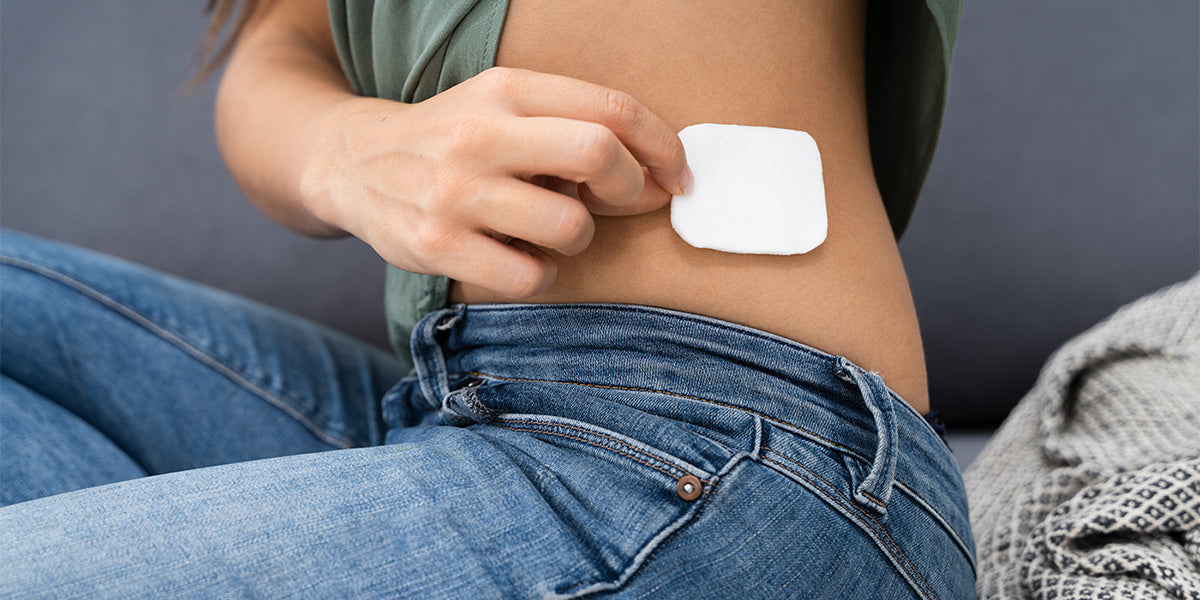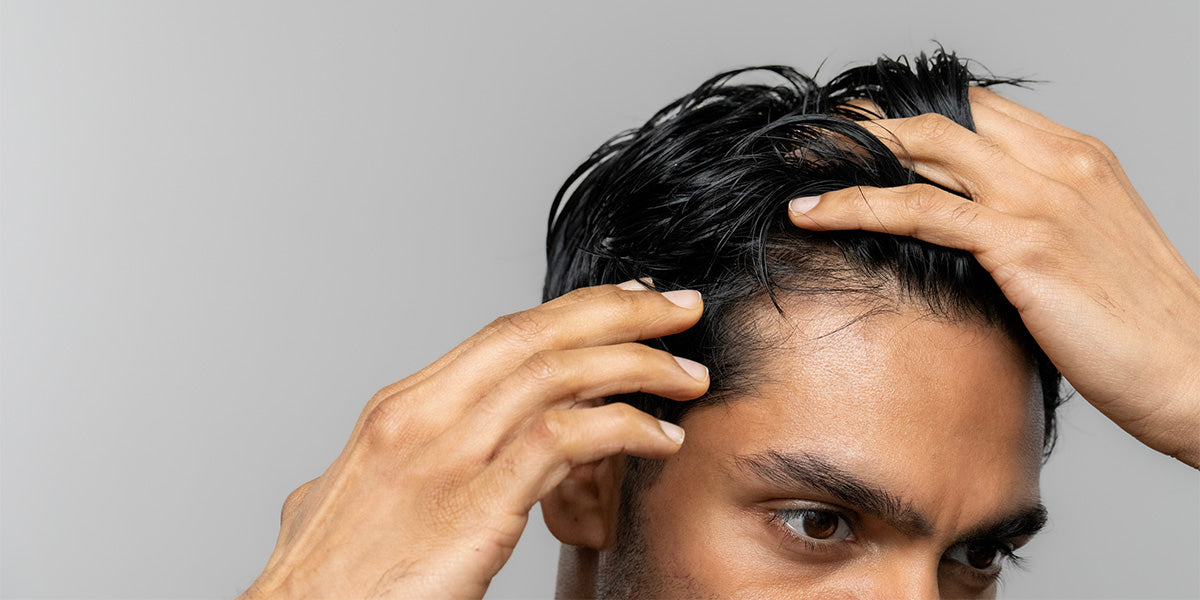Most people have heard about hot flashes and night sweats being the typical symptoms of menopause, but a less spoken symptom that can occur throughout menopause is hair loss. Hormone replacement therapy (HRT) can offer relief of menopausal symptoms for many women, but does this include hair loss? Can HRT help with hair loss or does it make hair loss worse?
What is hormone replacement therapy?
During menopause, the main ‘female hormones’, estrogen and progesterone decrease significantly. This can result in testosterone (typically known as a ‘male hormone') becoming the more dominant hormone. In some women, this can cause significant physical and mental effects on the body including hot flashes and night sweats. But research has shown that menopause can also have a large impact on the hair growth cycle, sometimes resulting in female pattern hair loss and excess facial hair growth.
HRT typically uses estrogen and progestin (a synthetic progesterone), which may be used together or individually. The aim of HRT is to return hormonal levels back to where they were prior to menopausal changes and research has shown that HRT can reduce symptom intensity by almost 90% within one month of taking it (Khan et al, 2023).


Get To The Root Of Your Hair Loss
XYON hair specialists will evaluate your hair loss so you get the right solution.
Although it allows many women to go through this life transition more comfortably, there are some side effects to be aware of, including breast pain or tenderness, mood changes and hair loss. (Cameron et al,2023).
How does menopause cause hair loss?
Estrogen and progesterone are thought to be important in prolonging the active growth phase of the hair growth cycle, known as the anagen stage (Desia et al, 2021). When these hormones drop during menopause, hairs on the scalp can enter the shedding phase more quickly and spend less time actively growing. This can lead to hair thinning and hair loss.
These hair growth cycle changes may be attributed to the predominance of testosterone, which can cause more dihydrotestosterone (DHT) to be produced. DHT is the primary hormone responsible for male pattern hair loss, which also appears to play a role in the development of female pattern hair loss. In women who are genetically susceptible to hair loss, high levels of DHT at the scalp cause hair follicles to shrink and produce weaker hairs, which eventually leads to hair loss. In addition to DHT, other factors that can contribute to female pattern hair loss include genetics, age, hormones, underlying health conditions, such as endocrine disorders and certain medications.
Can HRT help with hair loss?
Potentially. Some women find that HRT is effective at returning their hormone levels close to what they were before menopause and with that, their hair growth returns to normal.
Estrogen therapy may help to manage and potentially reverse female pattern hair loss (androgenetic alopecia), but it is not a hair loss drug. So how does it affect hair growth?
Well, increasing estrogen levels may help to restore the estrogen-testosterone ratio in the body and inhibit the enzyme responsible for converting testosterone into DHT (Ohnemus et al, 2006). Progesterone is also believed to stop the production of DHT from testosterone (Randall, 2007). This mechanism of reducing the conversion of testosterone to DHT can prevent the shrinkage of hair follicles on the scalp (a process called follicular miniaturization) and may allow hair regrowth to occur. With that being said, estrogen and progestin therapies are not DHT-blocking drugs and it’s worth noting that treatments specifically targeting hair loss may be more effective.
It is also speculated that increasing estrogen and progesterone levels can positively impact the hair growth cycle, encouraging more hairs to remain in the active growth period and prevent hairs from entering the shedding phase (Gerard et al, 2023).
Does HRT cause hair to fall out?
Whilst some women find HRT helps with hair loss during menopause, others have speculated that it can make it worse or even trigger hair loss. Much like menopause itself, HRT causes significant alterations to hormone levels. As we know, our hair and hormones are closely linked, so any disruption to our hormones has the potential to have a negative impact on hair growth.
Although much less common, some women can be prescribed testosterone therapy to treat low libido during menopause. In fact, some research has found that testosterone can be highly beneficial for improving sexual well-being, self-image and other psychological symptoms of menopause (Scott & Newson, 2022). But on the flip side, testosterone can negatively impact hair growth and may trigger or worsen female pattern hair loss. Increasing the levels of testosterone can in turn increase DHT levels in the body, which may cause shrinkage of hair follicles and hair loss.
How to prevent hair loss with HRT
If you do experience hair loss with HRT, or notice increased shedding despite being on HRT, then it may be worthwhile looking at treatment options specifically for female hair loss.
Due to the complexity of hair loss in women, treatment is not always straight forward, but this doesn’t mean that you don’t have options. Topical minoxidil is currently the approved treatment for androgenetic alopecia in women it is effective in around 60% of patients (Ramos et al, 2023). Additionally, there has been an increasing use of off-label finasteride treatment for women and this has shown some positive results (Iamsumang et al, 2020).
We always recommend seeking professional medical advice at the first signs of hair loss, so that appropriate treatment can be started early. But in the meantime, it may be beneficial to incorporate natural hair growth products into your hair care routine. XYON’s Active Performance Shampoo and Conditioner for women is formulated with ingredients, such as biotinoyl-tripeptide and white nettle and honey locust. These are natural DHT-blocking substances which can help to target thinning hair and promote longer and fuller hair growth.
HRT and hair loss: Takeaway
Menopause can be a very difficult time in a woman’s life and HRT can make a significant difference to their quality of life. For some, it can not only alleviate the most common symptoms, but may also improve or even reverse hair loss resulting from the hormonal changes that occur during menopause. Yet for others, it can trigger or worsen hair loss. This can be distressing and may leave women with the difficult decision of stopping HRT in the hopes that their hair growth returns to normal, consequently having to live with other difficult symptoms. But it’s important not to lose hope.
Every individual is unique and responses to changing hormones can differ dramatically from person to person. If you do experience hair loss with HRT, there are other options you can explore, such as minoxidil and off-label finasteride, which are designed to help with hair loss specifically. We strongly encourage talking to a medical professional at the first signs of hair loss, so that you can get the support you deserve.
References List
Cameron, C.R., Cohen, S., Sewell, K., Lee, M. (2024). The art of hormone replacement therapy (HRT) in menopause management. Journal of Pharmacy Practice, 37(3), 736-740. https://doi.org/10.1177/08971900231167925
Desai, K., Almeida, B., Miteva, M. (2021). Understanding hormonal therapies: overview for the dermatologist focused on hair. Dermatology, 237(5), 786-791. https://doi.org/10.1159/000512888
Gerard, C., La Riche, A., Altendorf, S., Dion, V., Epping, L., Biro, T., Dixon, G., Bertolini, M. (2023). FRI378 Esterol prolongs anagen in healthy female scalp hair follicles by positively modulating dermal papilla functions and generation of progenitor cell ex vivo. Journal of The Endocrine Society, 7(1). https://doi.org/10.1210%2Fjendso%2Fbvad114.1574
Iamsumang, W., Leerunyakul, K., Suchonwanit, P. (2020). Finasteride and its potential for the treatment of female pattern hair loss: Evidence to date. Drug Design, Development and Therapy, 14, 951-959. https://doi.org/10.2147%2FDDDT.S240615
Khan, S.J., Kapoor, E., Faubion, S.S., Kling, J.M. (2023). Vasomotor symptoms during menopause: a pracitcal guide on current treatments and future perspectives. International Journal of Women’s Health, 15, 273-287. https://doi.org/10.2147%2FIJWH.S365808
Ohnemus, U., Uenalan, M., Inzuna, J., Gustafasson, J.A., Paus, R. (2006). The hair follicle as an estrogen target and source. Endocrine Reviews, 27(6), 677-706. https://doi.org/10.1210/er.2006-0020
Randall, V.A. (2007). Hormonal regulation of hair follicles exhibits a biological paradox. Seminars in Cell and Development Biology, 18(2), 274-85. https://doi.org/10.1016/j.semcdb.2007.02.004
Ramos, P.M., Melo, D.F., Radwanski, H., Almeida, R.F.C, Miot, H.A. (2023). Female pattern hair loss: therapeutic update. Anais Brasileiros de Dermatologia, 98(4), 506-519. https://doi.org/10.1016/j.abd.2022.09.006
Scott, A., Newson, L. (2020). Should we be prescribing testosterone to perimenopausal and menopausal women? A guide to prescribing testosterone for women in primary care. British Journal of General Practice, 70(693), 203-204. https://doi.org/10.3399%2Fbjgp20X709265




